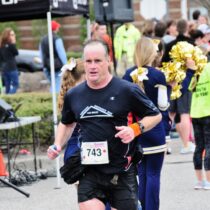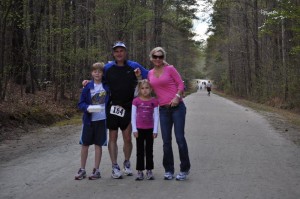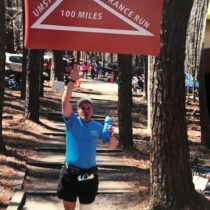“At some point during this race many of you will experience adversity; know that when you fight through those times and overcome, it will mold your character just as iron forges iron, and you will emerge with battle-tested armor.” – Race Director, Umstead 100 Ultramarathon
Ran 500+ miles in 2021 …. 2022 Update: Training for Ultra #6, December 3, 2022 !!!!
After finishing 12 marathons in 12 months, and completing 20+ marathons, I looked for another challenge: to see if I could finish a 50 mile Ultramarathon. I loved this experience as it pushed me far outside of all physical and psychological comfort zones. After training for six months, I ran 50, celebrated, yet was sad when finish line approached. This led to running my first 100 mile race a couple of years later. With those races under my belt I registered for the Umstead 100, determined to implement what I had learned in previous races.
In his book Ultramarathon Man, Dean Karnazes claimed that completing a 100 was exponentially more difficult than running a 50.
After running 100 miles twice … I have to say that Dean was absolutely correct. 50s and 100s are completely different races. I think most marathoners, with additional training, could gut out a 50 miler. But running 100 miles in one day requires another level of commitment and will.
Training for a 100-miler: If you’re reading this post and are training for your first 100 mile run, the best advice that anyone can give you is to simulate the fatigue you will experience between miles 75-99.
Note to self #1: Train well. If I ever run another 100 … Jim please train for 8+ months and do at least four 50 mile training runs! While some fitness coaches recommend doing back-to-back 25 mile runs on the weekend, those runs didn’t nearly approximate the rigor, physical and mental fatigue needed to gut it out past mile 75. While training with back-to-back runs can minimize injury, they delude runners into thinking that they’re “ready”, when they aren’t. I am NOT suggesting that a race plan shouldn’t include back-to-backs. What I am saying is that a runner shouldn’t be completely reliant on them. Personally, I would want at a minimum of three and optimally five 40-50 mile runs under my belt before race day.
The 100 Mile “Wall”: Where is it? I hit it pretty hard around mile 60 during my first 100-miler, gutted it out over the next 20 miles and then recovered to finish strongly. During my second 100 mile run, I had trained much differently and didn’t hit the wall until mile 91. Note to self #2: Be prepared because the wall (and other bad things) can come suddenly. When you hit the wall in an ultra race it’s not like in a marathon where you just walk-run. Recoveing is about survival, about heart, and the triumphs of overcoming. This is why you need to have a reason to do a race like this … if you’re doing it just “to do it” … you’ll quit when adversity comes. For me, I had personal goals about finding what’s on the other side of fear and learning how to silence voices of doubt. And I ran both races for people near and dear to my heart; more on that later.
Race Strategy: About 15 minutes into the race, I passed two older runners and overheard them talking about the biggest mistake made during an ultra: starting out too fast and not having enough energy to finish. After hearing this I slowed my pace. My strategy in my first ultra was to run the flats and downhills and walk the uphills for the first 50 miles. The plan for the next 50 was to will myself to the finish! If you’re thinking that’s not much of a plan, you’re right! However, when you haven’t run 100 miles before … everything is theoretical.
I planned to start in the middle of the pack to let the wave of runners carry me for the first few miles, however at 5:58am my race belt malfunctioned, sending me into a panic. Just as I stepped out of headquarters, walking toward the start line, the gun sounded sending me scrambling toward the start line and placing me at the very back of the pack. Not a great start to the race. However I had trained differently, and with multiple 50 mile training runs under my belt, I was confident I had what it took to finish.
During both races, my thoughts went to whom I had dedicated each race. In my first ultra I ran for the beautiful Make A Wish children in eastern North Carolina and kids at the UNC Children’s. I made a poster in their memory and saw their faces after each loop. In the second 100 miler, I ran for my friend Kirk Henry, who was battling (and subsequently beat) stage IV melanoma. Note to self #3: Do things with heart. More on this below.
Encountering Challenges:
During my first ultra, just after the start of the race I had a hard time getting my heart rate down to a manageable and sustainable level. Trouble was brewing. I knew I could run indefinitely at 120-130 beats per minute with proper nutrition. During the first 20 miles of the race my heart rate spiked as high as 160 bpm (beats per minute), averaging 140 BPM even when walking. Something was wrong. This was the first of several significant challenges I would have to face and overcome that day. Note to self #4: Stay composed and don’t freak out about things. I eliminated race day nerves as the potential culprit and it was too early in the race to be salt or nutrition deficient. It dawned on me that, after seeing dozens of runners stop in the porto johns, I could be dehydrated. I had been warned to eat and drink before feeling the need to and forced down some water and Gatorade. Wthin 20 minutes my legs, body, mind and heart were ready to run again and my spirits soared as I ran effortlessly for 12 hours. I felt so invincible that I anticipated a sub-24 hour finish.
During both races my wife and kids met me at an aid station and it was meaningful having them there to support me. I listened to various audio books along the way, including Seal Team Six and various musings by David Sedaris.
Crew Support: During the Umstead 100, runners can have pacers after mile 50.
I had given my pacers the following strict orders:
1. Talk a lot
2. Keep me loose and laughing
3. Distract me if I’m in pain
Note to self #5: What To Do When the Wheels Come Off:
My first pacer, Steve Lackey, the publisher of Endurance Magazine, was a wonderful pacer, and is one of the most positive and fascinating men I know.
For most of our time together Steve had no problem with orders #1 & 2, and he kept me in stitches. We hardly discussed anything about the race and I just enjoyed his company. Not long after passing the second aid station the sun began to fade as we approached the last hill on the back part of the course. That’s when things began to fall apart – at mile 58. Within seconds I fell from the highest peak to a mountain valley: From fully conscious and lucid, jocular and fast-moving to nauseous, disoriented and completely exhausted. I pleaded with Steve to let me stop but he had none of it. He told me we needed to make it to the aid station 4 miles ahead, which took an hour and a half. So much for that 24-hour finish dream; at this point I was hoping to just finish.
My blood sugar had dropped precipitously and I clearly didn’t have enough long-strand carbs feeding my muscles and brain. If I had actually used my noggen, at the aid station near mile 50 I would have stopped for a 1,000 calorie dinner on the go – to sustain me for the evening hours. Lessons learned.
Although exhausted with no appetite, I knew my body needed some carbs. I forced down some chicken noodle soup and a couple of PBJ squares and grabbed some Shot Blocks. Departing for the 6th loop was demoralizing. I had no energy, yet had 38 more miles to go. To make matters worse I felt something squishy on my foot and found a huge blister on my heel. This required attending and after another 20 minutes or so I was off into the dark with my another pacer, good friend Kean Hankins, an experienced ultra runner. Without his advice, encouragement and experience to manage my pain and fatigue – encouraging me to stick with my race plan – I likely wouldn’t have finished this race without him.
Miles 62.5 – 75 were fuzzy. I had found the “wall” that marathoners encounter at mile 22. With the euphoria of the start as well as spectators’ encouragement long gone, it was only will that kept me going. As the sun went down on the trail my energy waned. Many runners chose to go inside the race cabin to rest their feet by the fire. However I knew if went in I’d likely never return to the trail and stayed far away from that temptation. I had been warned by experienced ultra runners of the darkness – – that it sapped the remaining energy out of your body – – and they were right. I struggled up the long uphill climbs that I had ascended effortlessly earlier in the day. During one late evening climb, I smiled as colorful orange goldfish lit up the trail. Then it dawned on me that my eyes were closed and I had been dreaming while sleep-running. I shook myself awake, careful to avoid falling down into one of the steep culverts.
By mile 75 I had mostly recovered from near disaster several hours before. In order to finish I needed to consume the right foods and fuel. I became tense with 25 miles left to cover realizing that I couldn’t afford to make any additional mistakes. I stuffed cantaloupe into both pockets and my running belt. High in simple sugars and easy to digest, I easily consumed 6 cantaloupes over the last 25 miles.
When the sun arose over the horizon my spirits lifted, bringing extra pep in my step. My feet were badly blistered and sore. (Do you get my point about 25 mile back-to-back runs now?!) After finishing 87.5 miles I was in no mood to lollygag at the aid station, grabbed some more cantaloupe, a drink and headed out. Friends John and Michele joined me and I began to count down the miles. Single digits brought joy, yet I was careful to manage the highs and lows.
At mile 99, I looked at my watch and calculated that if I ran an eight-minute mile I could finish before 29 hours. I began running for the first time in hours- and it felt wonderful to open up into a full stride. I ran the last 800 meters in a full sprint. As I did, the many blisters on my feet popped which felt surprisingly great. With tears of joy in my eyes as I passed by the pictures of the Make a Wish children, I crossed the finish line and stopped my watch at 28:59:56, with an official time of 29:00:06 due to the malfunction with my race belt earlier in the race.
Final notes to self: There are many lessons to take from Ultra runs such as these. In my first ultra, I learned about breaking through physical and psychological barriers, and stretching my tolerance threshold. During my second 100 miler, I realized that circumstances are often neither quite as good, nor quite as bad as they appear to be. In both races, I learned more about becoming the master of any voices of doubt, which often get in the way of finding true contentment in life.
Specific Training Plan: Note – this might be boring unless you’re training for an Ultra!
Your Pre-Race Mindset: Run for a Reason
Let’s go back for a minute and discuss your pre-race mindset. I had decided that the only things that were going to stop me from finishing were broken bones sticking out of skin (lower extremities only counted!) and becoming unconscious. During the last 15 miles, either or both were possible, but didn’t occur. Yes, my feet were unbearably sore and blistered (even though I didn’t have a single blister during any of my training runs, but they weren’t going to stop me from finishing.
Weight and Core: Leg work was important; squats and leg extensions got me up the hills. Extensive core work (I did two 2-minute planks twice a day for the 3 months leading up to the race) and equipped me to keep going when half the field was quitting.
Taper: Like most runners, I really don’t like tapers. Prior to all 3 ultras my legs felt dead and I was convinced that my two-week reduction in mileage had caused me to get out of shape. Before a hundred mile run do not run more than 15 miles two weeks before the race. If possible, don’t run much if any the week before the race – 5 miles maximum. Rely on your training plan and follow the taper. Your worst nightmare is to be over-trained, with dead legs at mile 90.
Nutrition plan: Several months before the Umstead race, I read a race report about a runner who consumed one gel every half-hour during the race. Having run 20+ marathons I was familiar with “gu” and gels and was nauseated by the thought of consuming 50 of them during a race. I went to the store and bought 10 of Heed’s newest flavors, tried a few and quickly abandoned this strategy. Although the Key Lime and vanilla flavors weren’t bad, trying to choke down 50 over a 24 hour period was unthinkable.
My wife Susan had begun using PowerBar Ironman formula, which provided 175 calories, 42 grams of carbs, along with 475 mg of sodium and 30 mg of potassium. Although this wasn’t an ideal fit for me – as I would’ve preferred fewer simple sugars – one bottle provided the 2/3 of the energy required per hour, all of the electrolytes and fluids. It absorbed well. I tested it with all types of foods and ever got tired of drinking it.
My plan for additional energy was to eat every hour. I trained with PBJs stuffed into my running belt along with Toastchee, Nabs and Nekot crackers – salty sweet combinations which were easily consumable and digestible. During both 100s, PB&Js were my solid food staple along with cantaloupe – which I CRAVED during the race. Note: You will crave something during the race. During my first 50 miler, I devoured hotdogs and couldn’t get enough of them! In my first 100-miler in ’11, I consumed an entire pepperoni pizza on the run and during the race I devoured a footlong chicken sub sandwich.
Injuries: When training for an Ultra you are going to have injuries. They became so common place that I began to ignore them. What would’ve previously sent me to the podiatrist for treatment I began to run through. One day I would have fasciitis on my left foot and on my right the next. Toward the end of training I had significant hamstring issues and moderate ankle swelling from irritated soleus muscles. Glucosamine tablets really helped as did stretching and walking before long runs. I made it a ritual after all 30+ mile runs to walk barefoot for at least two miles on the pavement to force my feet to move naturally outside the confines of my shoes.
Pre-Race Planning:
Sleep: Three days before both hundred milers I forced myself to go to bed early and to get a at least 8 hours of sleep so that I wouldn’t start the race in a sleep deficit.
Supplies: I prepared three shoe boxes of materials and put them on a table next to my car:
Box 1: Comfort food
Box 2: Electronics (AM/FM radio, Ipod, portable charger and cell phone)
Box 3: Health supplies: Glide, Lava salts, tape, blister materials, lip balm, Ibuprophen, Tums, Immodium
Note: Nothing is worse than chafing during the latter miles of an ultra. Buy 2 bars of Glide, strip it off the bars and put it in a large pill bottle to put in your pocket.
Extra Clothes: I brought a complete change of clothes for mile 62.5, two extra pairs of shoes, and 3 different jackets. For the finish I brought some sweats and a pair of sandals to change into.
Day before the race:
My nerves peaked early in the week and several days before the race I tired of worrying. I attended the pre-race briefing but didn’t hear much due to nerves. I stayed off my feet most of the day and snacked on a pizza to make sure my glycogen stores were full!
Race Day: It’s a good thing to bank sleep the week of the race because, due to nerves, I generally don’t sleep much the night before races. I arrived at Umstead about 4:30am and was lucky both years to get a parking space adjacent to the course next to the bathrooms, just a short distance to HQ. I dropped off my Aid Station bag, consisting of 10 PowerBar bottles, some crackers, Gu, a jacket and extra pair of shoes.




